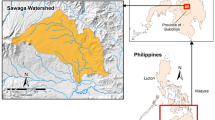Abstract
Flooding is one of the most recurring disasters. Evacuation planning is one of the fundamental instruments to mitigate negative impacts of this hazard to the community. Routing is part of evacuation planning that determines the best routes for relocating population. In this study, evacuation routing is focused to the output of the UP Mindanao Phil-LiDAR1. The Light Detection and Ranging (LiDAR) technology is an airborne mapping method that delivers geospatial data in the form of point clouds with high-accuracy elevation values and ground features. Building and road network features extracted from the LiDAR data were used to create network dataset. Flood hazard models were used to identify areas in the network that are at risk of flooding. Capacity Aware Shortest Path Evacuation Routing (CASPER) of the ArcGIS Network Analyst Tool’s extension was used to simulate evacuation routes. The tool uses the CASPER algorithm, a heuristic evacuation routing method that takes into account the capacity of the transportation network and the traffic flow in order to minimize traffic congestion. This study and the data it produced can help the local government units in their planning and disaster risk reduction management.
Access this chapter
Tax calculation will be finalised at checkout
Purchases are for personal use only
Similar content being viewed by others
References
Cole, J.W., et al.: GIS-Based emergency and evacuation planning for volcanic hazards in New Zealand. Bull. N. Z. Soc. Earthq. Eng. 38(3), 149–164 (2005)
Eguchi, R.T., Huyck, C.K., Ghosh, S., Adams, B.J.: The application of remote sensing technologies for disaster management. In: The 14th World Conference on Earthquake Engineering, Beijing, China (2008)
Linham, M.M., Nicholls, R.J.: Flood hazard mapping [WWW Document]. ClimateTechWiki (2010). http://www.climatetechwiki.org/content/flood-hazard-mapping. Accessed 01 Oct 2016
Lue, E., Wilson, J.P., Curtis, A.: Conducting disaster damage assessments with spatial video, experts, and citizens. Appl. Geogr. 52, 46–54 (2014). https://doi.org/10.1016/j.apgeog.2014.04.014
Mahmassani, H.S., Sbayti, H., Zhou, X.: DYNASMART-P version 1.0 user’s guide. Maryland Transportation Initiative, College Park, Maryland (2004)
Manliguez, C., Cuabo, P., Gamot, R., Ligue, K.: Solid waste collection routing optimization using hybridized modified discrete firefly algorithm and simulated annealing - a case study in Davao City, Philippines. In: Proceedings of the 3rd International Conference on Geographical Information Systems Theory, Applications and Management: GISTAM, vol. 1, pp. 50–61 (2017). https://doi.org/10.5220/0006322500500061. ISBN 978-989-758-252-3
Manliguez, C., Diche, Z., Jimenez, M., Agrazamendez, M., Acosta, J.: GIS-based evacuation routing using capacity aware shortest path evacuation routing algorithm and analytic hierarchy process for flood prone communities. In: Proceedings of the 3rd International Conference on Geographical Information Systems Theory, Applications and Management: GISTAM, vol. 1, pp. 237–243 (2017). https://doi.org/10.5220/0006327402370243. ISBN 978-989-758-252-3
NDRRMC: National Disaster Risk Reduction Management Council, Philippines (2014). www.ndrrmc.gov.ph. Accessed 04 Sept 2016
Ortega, A.: Philippines’ Country Report 2014 [WWW Document]. Country report, Asian Disaster Reduction Center (ADRC) (2014). http://www.adrc.asia/countryreport/PHL/2014/PHL_CR2014B.pdf. Accessed 31 Oct 2016
Shekhar, S., et al.: Experiences with evacuation route planning algorithms. Int. J. Geogr. Inf. Sci. 26(12), 2253–2265 (2012)
Santos, E.I.: CNN Philippines: Philippines among world’s most disaster-prone countries (2016). http://cnnphilippines.com/news/2015/11/25/philippines-fourth-most-disasterprone-country.html. Accessed 14 July 2016
Project NOAH: DOST - Nationwide Operational Assessment of Hazards (2016). http://noah.dost.gov.ph/. Accessed 04 Sept 2016
Santos, G., Aguirre, B.E.: A critical review of emergency evacuation simulation models. In: Building Occupant Movement During Fire Emergencies. Disaster Research Center, University of Delaware (2004)
Shahabi, K.: Out of Harm’s Way: Enabling Intelligent Location-Based Evacuation Routing [WWW Document]. ArcUSER (2012). http://www.esri.com/news/arcuser/0612/out-ofharms-way.html. Accessed 02 Oct 2016
Shahabi, K., Wilson, J.P.: CASPER: intelligent capacity-aware evacuation routing. Comput. Environ. Urban Syst. 46, 12–24 (2014). https://doi.org/10.1016/j.compenvurbsys.2014.03.004
Shahabi, K.: Scalable evacuation routing in dynamic environments. University of Southern California (2015)
Acknowledgements
This study is under the Phil-Lidar 1.B.13 research project of the University of the Philippines Mindanao that is funded by the Department of Science and Technology (DOST) and the Philippine Council of Industry, Energy and Emerging Technology Research and Development (PCIEERD) of the Philippines.
Author information
Authors and Affiliations
Corresponding author
Editor information
Editors and Affiliations
Rights and permissions
Copyright information
© 2019 Springer Nature Switzerland AG
About this paper
Cite this paper
Diche, Z.J., Manliguez, C., Jimenez, M.J., Agrazamendez, M., Acosta, J. (2019). Optimal Evacuation Routing Using LiDAR-Based Flood Models. In: Ragia, L., Laurini, R., Rocha, J. (eds) Geographical Information Systems Theory, Applications and Management. GISTAM 2017. Communications in Computer and Information Science, vol 936. Springer, Cham. https://doi.org/10.1007/978-3-030-06010-7_9
Download citation
DOI: https://doi.org/10.1007/978-3-030-06010-7_9
Published:
Publisher Name: Springer, Cham
Print ISBN: 978-3-030-06009-1
Online ISBN: 978-3-030-06010-7
eBook Packages: Computer ScienceComputer Science (R0)




